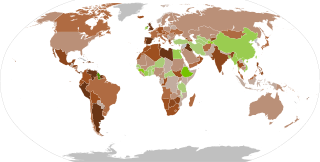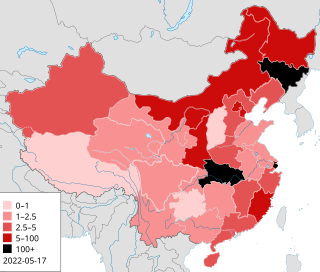This article needs to be updated.(March 2024) |
A series of economic crises have affected China since the country enacted its zero-COVID policy during the COVID-19 pandemic.
This article needs to be updated.(March 2024) |
A series of economic crises have affected China since the country enacted its zero-COVID policy during the COVID-19 pandemic.
In December 2019, the first case of SARS-CoV-2 was reported in Wuhan. [1] The outbreak in January 2020 was the impetus for a broader pandemic; the World Health Organization formally declared a pandemic on 11 March. [2] In response, Xi Jinping's administration pursued a zero-COVID policy. On 23 January, amid a rising death toll, the Chinese government imposed a travel lockdown on Wuhan, confining citizens within the city. [3] In March, nearly all foreigners were barred from entering the country. [4]
In August 2020, the Chinese government enacted new regulations on the amount of debt property developers can incur. The new regulations affected Evergrande Group, China's second-largest property developer, and the Chinese real estate market as a whole. [5]
Financing affiliates in local governments—who depend upon the vitality of the real estate market—responded to the property sector crisis by borrowing the land that developers can no longer afford. The excess borrowing has created a debt crisis; China has lent nearly US$1 trillion to over a hundred developing countries. [6]
Since January 2023, the unemployment rate among young people in China has risen. In August, the Chinese government suspended its monthly unemployment report. [7]
The CSI 300 index, which contains the largest and most liquid Shanghai- and Shenzhen-listed stocks, shedding more than 6% in January, 2024. [8]

The 2005 Chinese property bubble was a real estate bubble in residential and commercial real estate in China. The New York Times reported that the bubble started to deflate in 2011, while observing increased complaints that members of the middle-class were unable to afford homes in large cities. The deflation of the property bubble is seen as one of the primary causes for China's declining economic growth in 2013.
Real estate in China is developed and managed by public, private, and state-owned red chip enterprises.

The COVID-19 pandemic, also known as the coronavirus pandemic, is a global pandemic of coronavirus disease 2019 (COVID-19) caused by severe acute respiratory syndrome coronavirus 2 (SARS-CoV-2). The novel virus was first identified in an outbreak in Wuhan, the capital of Hubei, China, in December 2019, before it spread to other areas of Asia, and then worldwide in early 2020. The World Health Organization (WHO) declared the outbreak a public health emergency of international concern (PHEIC) on 30 January 2020, and assessed the outbreak had become a pandemic on 11 March 2020. The WHO ended the PHEIC on 5 May 2023. As of 1 May 2024, the pandemic has caused 7,045,569 confirmed deaths, making it the fifth-deadliest pandemic or epidemic in history.

On 23 January 2020, the central government of China imposed a lockdown in Wuhan and other cities in Hubei in an effort to quarantine the center of an outbreak of COVID-19; this action was commonly referred to as the Wuhan lockdown. The World Health Organization (WHO), although stating that it was beyond its own guidelines, commended the move, calling it "unprecedented in public health history".

The COVID-19 pandemic in mainland China is part of the worldwide pandemic of coronavirus disease 2019 (COVID-19) caused by severe acute respiratory syndrome coronavirus 2 (SARS-CoV-2). China was where the first COVID outbreak occurred, the first where authorities imposed drastic measures in response, and was one of the first countries to bring the outbreak under control, at least temporarily.

The COVID-19 pandemic began in Asia in Wuhan, Hubei, China, and has spread widely through the continent. As of 1 May 2024, at least one case of COVID-19 had been reported in every country in Asia except Turkmenistan.
The COVID-19 pandemic in Hubei, part of the global COVID-19 pandemic, was the first identified outbreak of the pandemic, appearing as a cluster of mysterious pneumonia in Wuhan, the provincial capital of Hubei, China. A Wuhan hospital notified the local Center for Disease Control and Prevention (CDC) and health commissions on December 27, 2019. On December 31, Wuhan CDC admitted that there was a cluster of unknown pneumonia cases related to the Huanan Seafood Wholesale Market after the unverified documents appeared on the Internet. The outbreak soon drew nationwide attention, with the National Health Commission (NHC) in Beijing sending medical experts to Wuhan the next day. On January 8, a new coronavirus was identified as the cause of the pneumonia. The sequence of the virus was soon published on an open-access database. Measures taken by China have been controversial. They were praised by the World Health Organization (WHO) for improvements over SARS-CoV-2 responses, but maligned by many in the international community for being slow to publicly disclose key facts or deceptive about the outbreak and for aggressively censoring information related to the outbreak and public discontent from citizens online.
The COVID-19 pandemic in Cambodia was a part of the ongoing worldwide pandemic of coronavirus disease 2019 caused by severe acute respiratory syndrome coronavirus 2. The first imported case in Cambodia was detected in Sihanoukville on 27 January 2020. Although a number of imported cases and transmission to direct contacts were confirmed throughout 2020, no community transmission was detected until 29 November 2020. As of July 2021, Phnom Penh has been the most affected province with the majority of infections and deaths. Banteay Meanchey has the second-highest number of infections, whereas Kandal has second-highest number of deaths.

The COVID-19 pandemic in North Korea was part of an global pandemic of coronavirus disease 2019 (COVID-19), a novel infectious disease caused by severe acute respiratory syndrome coronavirus 2 (SARS-CoV-2). North Korea confirmed its first case on 8 May 2022.

The COVID-19 recession, also known as the Great Lockdown, was a global economic recession caused by the COVID-19 pandemic. The recession began in most countries in February 2020. After a year of global economic slowdown that saw stagnation of economic growth and consumer activity, the COVID-19 lockdowns and other precautions taken in early 2020 drove the global economy into crisis. Within seven months, every advanced economy had fallen to recession.

This article documents the chronology of the response to the COVID-19 pandemic in May 2020, which originated in Wuhan, China in December 2019. Some developments may become known or fully understood only in retrospect. Reporting on this pandemic began in December 2019.

The COVID-19 pandemic has had far-reaching economic consequences including the COVID-19 recession, the second largest global recession in recent history, decreased business in the services sector during the COVID-19 lockdowns, the 2020 stock market crash, which included the largest single-week stock market decline since the financial crisis of 2007–2008 and the impact of COVID-19 on financial markets, the 2021–2023 global supply chain crisis, the 2021–2023 inflation surge, shortages related to the COVID-19 pandemic including the 2020–present global chip shortage, panic buying, and price gouging. It led to governments providing an unprecedented amount of stimulus. The pandemic was also a factor in the 2021–2022 global energy crisis and 2022–2023 food crises.
This is an economic history of the 2020s. Economic history refers to the study of economies or economic events of the past, including financial and business history.

Zhang Yongzhen, also known as Yong-Zhen Zhang, is a Chinese virologist known for his work relating to the COVID-19 pandemic. A professor at Fudan University, Zhang has discovered numerous RNA viruses and created a network of labs dedicated to monitoring new viruses. He led the team that sequenced and published the genome of SARS-CoV-2, the virus that causes COVID-19, in early January 2020.
The Chinese government has actively engaged in disinformation to downplay the emergence of COVID-19 in China and manipulate information about its spread around the world. The government also detained whistleblowers and journalists claiming they were spreading rumors when they were publicly raising concerns about people being hospitalized for a "mysterious illness" resembling SARS.

The Chinese property sector crisis is a current financial crisis sparked by the 2021 default of Evergrande Group. Evergrande, and other Chinese property developers, experienced financial stress in the wake of overbuilding and subsequent new Chinese regulations on these companies' debt limits. The crisis spread beyond Evergrande in 2021 to such major property developers as Country Garden, Kaisa Group, Fantasia Holdings, Sunac, Sinic Holdings, and Modern Land.

During the COVID-19 pandemic in mainland China, the government of China under CCP general secretary Xi Jinping's administration pursued a zero-COVID strategy to prevent the domestic spread of COVID-19 until December 7, 2022. Aspects of the response have been controversial, with the zero-COVID approach being praised and the government's lack of transparency, censorship, and spread of misinformation being criticized. The government abandoned its zero-COVID policy on 7 December 2022.

Zero-COVID, also known as COVID-Zero and "Find, Test, Trace, Isolate, and Support" (FTTIS), was a public health policy implemented by some countries, especially China, during the COVID-19 pandemic. In contrast to the "living with COVID-19" strategy, the zero-COVID strategy was purportedly one "of control and maximum suppression". Public health measures used to implement the strategy included as contact tracing, mass testing, border quarantine, lockdowns, and mitigation software in order to stop community transmission of COVID-19 as soon as it was detected. The goal of the strategy was to get the area back to zero new infections and resume normal economic and social activities.

The 2019–2020 COVID-19 outbreak in mainland China was the first COVID-19 outbreak in that country, and the beginning of the COVID-19 pandemic, caused by severe acute respiratory syndrome coronavirus 2 (SARS-CoV-2). China was the first country to experience an outbreak of the disease, the first to impose drastic measures in response, and one of the first countries to bring the outbreak under control.
2020s commercial real estate distress was a worldwide spike in commercial real estate distress that began in the 2020s in the wake of the COVID-19 pandemic and interest rates hikes by central banks in response to the 2021 inflation crisis. Although the increase in distress occurred globally it was most acute in the United States and China.